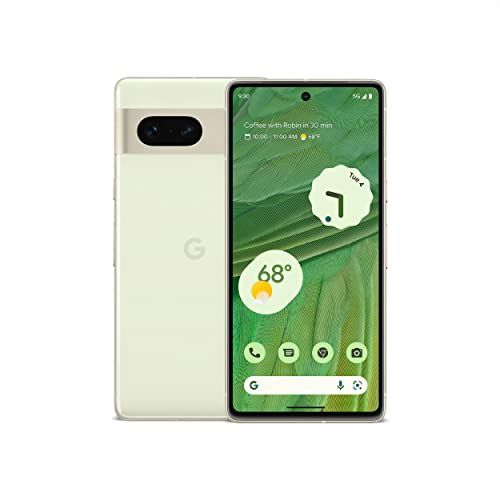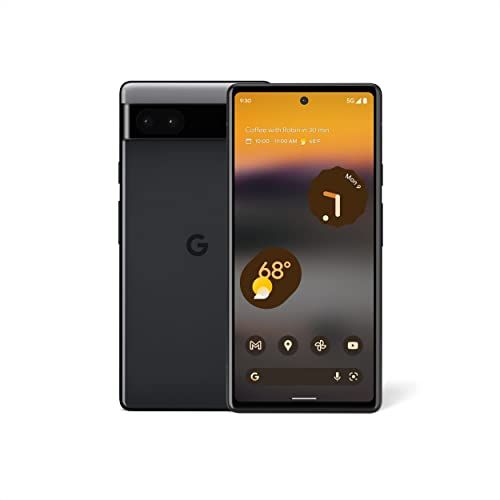When the Google Pixel 6a first came out, we were keen to see just how different it was from the more expensive, but older, Pixel 6. We discovered there wasn't really a huge amount of difference in performance.
Now that the Pixel 7 is out - and has replaced the Pixel 6 - again our curiosity got the better of us. Does the new Pixel 7 ramp things up enough that you should spend the extra cash, or should you save money and get the cheaper model? In this guide we explain all the key differences, having spent considerable time testing both phones.
Design
- Pixel 7: 155.6 x 73.2 x 8.7 mm - 197g
- Pixel 6a: 152.2 x 71.8 x 8.9 mm - 178g
- Pixel 7: Gorilla Glass Victus front and back - Aluminium frame
- Pixel 6a: Gorilla Glass 3 front, plastic back - Aluminium frame
- Pixel 7: IP68 water and dust resistant
- Pixel 6a: IP67 water and dust resistant
There are a few things worth noting on the design side of things that can make the difference to the experience of using these two phones. And there are positives and negatives to both.
They both clearly look like they belong in the same family. They have that same square look with minimally rounded corners that give them an almost perfectly rectangular shape. In the Pixel 6a's favour, there's the fact that it is narrower, shorter and lighter, and that does make a difference. It has a more compact feel, making it a tiny bit more single hand friendly.
There's no denying however, that the construction and materials of the Pixel 7 are sturdier and more robust feeling. The frame feels a lot more rigid, undoubtedly helped by the solid aluminium camera bar that runs along the back. With that - plus the fact it's covered in Gorilla Glass Victus - it should be able to take more of a beating than the Pixel 6a with its plastic back.
Still, on an objective level, both are water and dust resistant to high levels. IP68 on the Pixel 7 and IP67 on the Pixel 6a, and that means they'll both do just fine with the usual kinds of accidental contact with water that befalls phones sometimes.
There are a couple of other minor things. One is the bezel around the display. The thinner frame on the Pixel 7 gives more of a feeling that the content is immersing you, or taking up more of that front surface area. Another is the positioning of the buttons. They're slightly lower down on the Pixel 7, and that makes them just a tiny bit easier to reach.
Display and media
- Pixel 7: 6.3-inch, 1080 x 2400 AMOLED display
- Pixel 6a: 6.1-inch, 1080 x 2400 AMOLED display - HDR
- Pixel 7: 90Hz refresh rate - HDR10+
- Pixel 6a: 60Hz refresh rate - HDR
- Both: Android 13
Google made the decision to use a tiered refresh rate system on its Pixel range this year. That means you get 60Hz on the lowest model - the Pixel 6a - 90Hz on the Pixel 7, and up to 120Hz on the Pro.
It's always worth remembering with refresh rates that once you're in your content - watching videos or playing popular games - it's rare to have one that needs more than 60Hz. However, that doesn't mean you can't see a difference between the 7 and the 6a. But it's usually just in the general software or user interface of the phone that we'd spot it.
Scrolling quickly through the app drawer and settings menus, or sliding down the notification and quick setting shade, or just swiping to go home, the Pixel 7 definitely seems smoother and that gives the illusion that it's more responsive. You don't see as much stuttering when things are moving quickly on screen, and icons and text stay sharp in motion.
From a purely visual standpoint there's a difference too. Both have a similar approach to colours and they have identical resolution, but there's no doubt the panel on the 7 is better than the 6a.
It's brighter for one and delivers high contrast, so HDR content is more effective, and you don't need to turn it up as high to enjoy watching video. With the two displays at 50-per cent brightness, the Pixel 7 was more vibrant, with really good bright spots where the Pixel 6a was a little more muted with the same setting.
When you get out in bright daylight it basically means at the extreme end you'll be able to see the Pixel 7 screen clearer. As for loudspeaker sound, neither has phenomenal stereo speakers. Both have a system where the bottom edge speaker is much fuller and louder than the top one, and so you don't really get that fully balanced stereo sound.
Performance and battery
- Pixel 7: Tensor G2 processor - 8GB RAM - 128GB/256GB storage
- Pixel 6a: Tensor (1st gen) processor - 6GB RAM - 128GB storage
- Pixel 7: 4355mAh battery - 30W wired charging - 20W wireless charging
- Pixel 6a: 4410mAh battery - 18W wired charging
What's really interesting from a performance standpoint is that when it comes opening apps, games and such, there's not a massive amount of difference in every day usage in terms of what the two phones can handle. They'll both be just as good for opening your favourite games, thanks to the fact that the 6a uses the Tensor processor. That's the same chipset that's in last year's flagship 6 and 6 Pro.
Like we mentioned when comparing the displays, however, you will notice a bit of extra smoothness from the Pixel 7 in certain areas, and that helps give it a feeling that's a bit faster.
Another area we did notice a difference was in the temperature. We're used to phones getting a little warm sometimes after extended periods of gaming, or using the camera, but with the Pixel 6a it was far more noticeable. It gets pretty warm under load, where the Pixel 7 doesn't really seem too.
The 7 seems to be able to cope better during longer stints of gaming, video watching and camera usage.
As for battery life, there's really not much in it. Capacities are very similar. It's 4410mAh on the Pixel 6a and 4355 on the Pixel 7. That translates to the two phones having extremely similar life. A full charge should comfortably get you through a day, and on most days - with 2-3 hours usage split between games and social media - we got to the end of a day with over 30 per cent left over after taking the phone off charge at 7:30am.
Cameras
- Pixel 7: 50MP f/1.9 main camera - 12MP f/2.2 ultrawide - 10.8MP selfie camera
- Pixel 6a: 12.2 f/1.7 main camera - 12MP f/2.2 ultrawide - 8MP selfie camera
Cameras were always going to be an interesting comparison point between the Pixel 7 and Pixel 6a. If only because so much of what makes Pixel cameras good is actually in the processing and machine learning elements. In some scenarios, then, the two can take very similar pictures with the same approach to contrast, colours and detail. But that's not to say they're the same.
In daylight the first thing we noticed using them side by side was that the Pixel 7's main camera has a wider field of view. So it fits a little more of the scene in, and allows you to get be a little closer to your subject if you need to.
It also seemed to handle light and colour a little differently, drawing in more light and detail where - by comparison - the 6a's images just looked a tiny bit more contrast heavy and dark. And this was consistent across the main and ultrawide lenses.
Of course, the big difference is zoom level. The higher resolution main sensor means Pixel 7 can digitally zoom further; all the way up to 8x in fact. At 2x zoom, it still looks nice and sharp. At 8x, the detail does fall away a bit, but it does give you that extra versatility. Pixel 6a stops at 2x zoom.
When you get into low light situations, the Pixel 7's upgraded tensor chipset seems to handle it better, taking night time shots quicker. You can manually increase the capture time if you want as well, allowing you to draw in more light, lifting more detail from the shadows than what we saw on the Pixel 6a. What's more, the Pixel 7 - as a result of better light and colour processing - was much better at retaining those colours in the background, where Pixel 6a often washed them out or created execessive noise and lacked a little detail.
Pixel 6a is still a powerful camera though, offering the astrophotography mode that automatically detects when it's stable and mounted to a tripod and enabling it to take picture of the stars at night. The Pixel 7 did lift more light here again, but the fact a mid-range phone can even do this is pretty impressive.
Pixel 7 has more up its sleeve in video mode too, with the ability to capture 10-bit HDR footage, giving you more dynamic range. It also has cinematic mode which is fun, but actually quite rough around the edges. It struggles to accurately detect edges and often has weird ripples around objects where it's being confused by foreground and background.
Price
- Pixel 7: from £599
- Pixel 6a: £399
In the UK, the Pixel 7 is £200 more expensive than the Pixel 6a. The 128GB model costs £599, where the 256GB version is £699. Given the performance and capabilities of the phone, that's very competitive.
As for the Pixel 6a, the full retail price is £399, but now that it's a few months old you should be able to find it cheaper at various retailers.
Conclusion
The interesting thing we find here - after comparing the two - is that both of these phones are great value for money, and that the extra you pay for the Pixel 7 does get you a better phone. It's better made, feels more durable, has a better camera system, wireless charging, smoother animations and a brighter display. So you definitely get what you pay for. If you want the better experience, it's the one to go for.
However, now that it's a little older and a little cheaper, the Pixel 6a is still a stunning phone for the money, and one that still delivers the key Pixel experiences for those who either can't or don't want to spend more.



